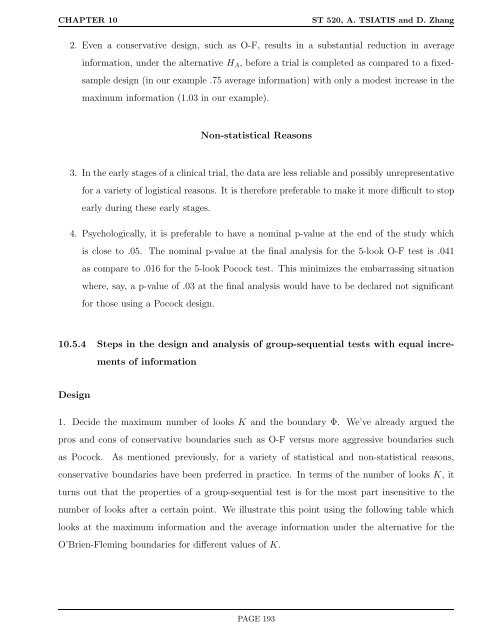ST 520 Statistical Principles of Clinical Trials - NCSU Statistics ...
ST 520 Statistical Principles of Clinical Trials - NCSU Statistics ...
ST 520 Statistical Principles of Clinical Trials - NCSU Statistics ...
Create successful ePaper yourself
Turn your PDF publications into a flip-book with our unique Google optimized e-Paper software.
CHAPTER 10 <strong>ST</strong> <strong>520</strong>, A. TSIATIS and D. Zhang<br />
2. Even a conservative design, such as O-F, results in a substantial reduction in average<br />
information, under the alternative HA, before a trial is completed as compared to a fixed-<br />
sample design (in our example .75 average information) with only a modest increase in the<br />
maximum information (1.03 in our example).<br />
Non-statistical Reasons<br />
3. In the early stages <strong>of</strong> a clinical trial, the data are less reliable and possibly unrepresentative<br />
for a variety <strong>of</strong> logistical reasons. It is therefore preferable to make it more difficult to stop<br />
early during these early stages.<br />
4. Psychologically, it is preferable to have a nominal p-value at the end <strong>of</strong> the study which<br />
is close to .05. The nominal p-value at the final analysis for the 5-look O-F test is .041<br />
as compare to .016 for the 5-look Pocock test. This minimizes the embarrassing situation<br />
where, say, a p-value <strong>of</strong> .03 at the final analysis would have to be declared not significant<br />
for those using a Pocock design.<br />
10.5.4 Steps in the design and analysis <strong>of</strong> group-sequential tests with equal incre-<br />
Design<br />
ments <strong>of</strong> information<br />
1. Decide the maximum number <strong>of</strong> looks K and the boundary Φ. We’ve already argued the<br />
pros and cons <strong>of</strong> conservative boundaries such as O-F versus more aggressive boundaries such<br />
as Pocock. As mentioned previously, for a variety <strong>of</strong> statistical and non-statistical reasons,<br />
conservative boundaries have been preferred in practice. In terms <strong>of</strong> the number <strong>of</strong> looks K, it<br />
turns out that the properties <strong>of</strong> a group-sequential test is for the most part insensitive to the<br />
number <strong>of</strong> looks after a certain point. We illustrate this point using the following table which<br />
looks at the maximum information and the average information under the alternative for the<br />
O’Brien-Fleming boundaries for different values <strong>of</strong> K.<br />
PAGE 193
















